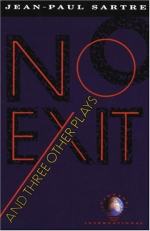|
This section contains 291 words (approx. 1 page at 400 words per page) |

|
No Exit Summary & Study Guide Description
No Exit Summary & Study Guide includes comprehensive information and analysis to help you understand the book. This study guide contains the following sections:
This detailed literature summary also contains Bibliography and a Free Quiz on No Exit by Jean-Paul Sartre.
Jean-Paul Sartre's No Exit is considered by many to be the author's best play and most accessible dramatization of his philosophy of existentialism. Sartre wrote the original draft in two weeks at the Café Flore in Paris. Titled Huis clos in the original French, it was first produced in Paris's Vieux-Colombier Theater. At the time, during World War II, this part of France was occupied by Nazi Germany. Sartre deliberately wrote No Exit as a one-act play so that theater-goers would not be kept past the German-imposed curfew. Many forms of entertainment, including plays, had to be approved by German censors. During rehearsals, clearance to perform the play was given and taken away several times. Despite such setbacks, No Exit opened in the spring of 1944, and it was an immediate success. The original production played in Paris for several years, even after the war ended and Paris was liberated. Parisian audiences appreciated Sartre's subtle message of resistance and implied subversiveness. Critics, however, gave it mixed reviews, mostly because of the social and political climate of the time. The fact that Inez was a lesbian was an extremely controversial point for both audiences and critics alike.
No Exit was translated into English (and is sometimes known as Behind Closed Doors), and made its Broadway debut in 1947. In general, American audiences were not as appreciative as their European counterparts. Some critics did not know what to make of the play and its themes. Others thought that the play stretched the fundamental concept to its breaking point. Still, most appreciated the clever concept: three people confined to a drawing room as their punishment in hell. Despite these mixed reviews, No Exit was voted the Best Foreign Play in New York in 1946.
Read more from the Study Guide
|
This section contains 291 words (approx. 1 page at 400 words per page) |

|



